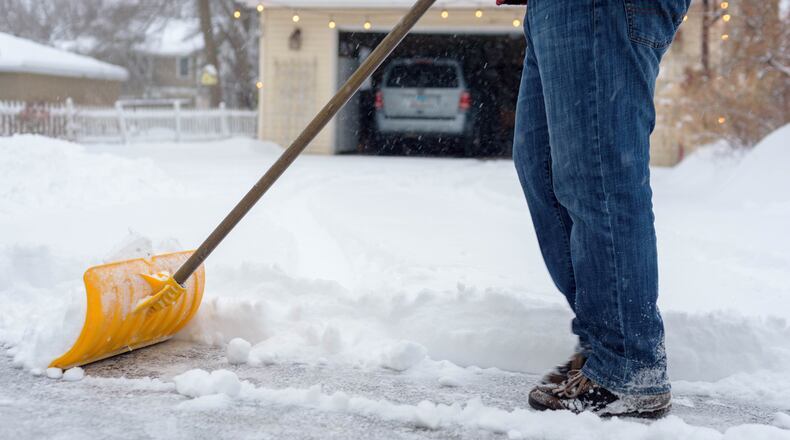Most people have been shoveling snow for years and have perfected their own system, so why is form and safety so important? There are many hidden risks that come with dealing with the winter elements, including exposure to cold air and temperatures and falling on icy paths.
“The most immediate safety challenge while shoveling would be icy walkways,” said Eric Buschur, a physical therapist with Kettering Health. “This safety risk can be mitigated by being aware of where you are and what the ground condition looks like so you can make adjustments that can help with balance and help prevent slipping, such as taking shorter steps and walking with your toes turned out very slightly – think of it as walking like a penguin.”
Falling on ice can lead to a sore backside, broken bones or head injuries. Shoveling snow is also strenuous on the heart. According to the American Heart Association, shoveling involves mostly arm work, which is more demanding on the heart than leg work. The organization also noted that some people hold their breath when lifting a heavy load, like snow, which can increase the heart rate and blood pressure.
Breathing in cold air constricts blood vessels, which further increases blood pressure as well.
Pulled muscles and injuries are outcomes that can accompany shoveling snow. The physical act of lifting a heavy element and a person turning their body can put people at risk for back problems.
“Lower back pain can result after shoveling snow and is probably the most common injury suffered because of the mechanics involved,” Buschur said. “Repetitive bending, lifting, and twisting, which are very common in snow shoveling, can cause disc bulging and herniation due to the repetitive loading force on the disc. It can also result in your facet joints, or the part of the spine where one vertebrae interacts with the next vertebrae in the back of the structure, becoming mis-aligned and causing limitations to your ability to move your spine.”
Before heading outside, it may be best to warm up with gentle stretches. Buschur recommends that prolonged stretching afterward for the back and hamstrings can be beneficial.
Below are a few more tips from Buschur.
Advice for seniors who need to clear their property?
Always be mindful that even younger people have limitations to what they can do. If you find shoveling your own driveway to be a point of pride that you want to continue doing, pay attention to your limitations. Be aware of your body mechanics. Take a rest when you need one. Drink plenty of water (doing heavy work while bundled up can make you sweat a lot!). Take your time and limit how much snow you have in each scoop, especially if it’s a more-wet snow.
Advice for proper form while shoveling snow?
One main piece of advice is to remember that shoveling is very similar to lifting something heavy from the floor. Do what you can do to minimize bending/lifting/twisting all at the same time. Unfortunately, shoveling frequently involves all three motions, so remember to minimize each. You can do this by making sure you maintain the backwards arch in your lumbar (lower back) spine and not reaching out too far when scooping the snow. Reduce the force involved by not taking such full scoops of snow, especially when the snow is heavier and/or more wet. Use a push-style shovel when possible. Use your core muscles to support your lower back as well by bracing your muscles as if somebody is trying to poke your belly and you’re blocking it, but don’t hold your breath! Don’t make the mistake of thinking that you don’t have to be aware of your mechanics when the snow is lighter; even when we pick up light objects, we can still cause injuries with bad mechanics!
How can seniors know if they are overdoing it while shoveling?
For cardiovascular purposes people should monitor their heart rate and perceived exertion/how hard they feel like they’re working. If their heart rate feels like it’s increasing substantially or if they feel like their workload is near maximum level, they should consider taking a rest periodically rather than focus on getting the whole driveway/walkway shoveled at one time.
2As far as overuse injuries go, if you start to experience pain, let that be your guide that you need to either change your mechanics or take a rest.
About the Author
